The steady increase in the number of wooden buildings has become one of the most iconic phenomena ...
|
|
Starting the repair in the bathroom, first evaluate its general condition. Sometimes... |
Layout of the bathrooms and plumbing devices in country houses and dachas ... |
Pouring the floor with a self -leveling mixture

An integral stage of any construction and finishing work is checking and preparing the surface. In this regard, you need to carefully try to get a perfectly even base for laying the flooring. In most cases, the installation of a concrete screed does not guarantee the presence of a perfectly flat surface, especially if its installation was carried out by the master without sufficient work experience. In the premises where the subsequent laying of linoleum, laminate or tiles is subsequently planned, this problem is especially relevant. If several decades ago, the alignment of the surface was considered a rather time -consuming process, which is the prerogative of only professional finishes, today this event has been greatly simplified due to the appearance of self -leveling mixtures for the floor, even though they can hardly be called cheap pleasure. The use of these mixtures is advisable in those rooms where the level of level does not exceed one two centimeters. Due to the fact that the use of this mixture has significantly simplified the technology of equalizing the base for laying the finish coating, it quickly gained popularity not only among inexperienced newcomers, but also of first -class specialists. Despite the fact that the technology for working with self -leveling mixtures in general terms is known even to a non -professional, it is important to know that they are not suitable for work with all surfaces. In this article, we will consider the main nuances of working with self -leveling mixtures for the floor, the main varieties of these mixtures and their composition, as well as the advantages and disadvantages of the material.
Content
- Using self -leveling mixtures: the relevance of the issue
- Varieties of self -leveling mixtures: the main characteristics
- Composition of a self -leveling mixture: tips for choosing a material
- Advantages of self -leveling mixtures: what to look for?
- Self -leveling mixture for the floor: material consumption
- Pouring the floor with a self -leveling mixture: step -by -step instructions
Using self -leveling mixtures: the relevance of the issue
Self -leveling floor is one of the most effective achievements of innovative technologies in the field of construction. But this does not mean that you can take on the installation of a self -leveling floor without much thought every master, especially inexperienced, should think carefully before taking up the implementation of this technology at home. The fact is that the effectiveness of the spreading base is determined not by its cheapness, which is due to the high cost of components of the self-leveling mixture and equipment, which for the traditional cement-concrete screed is much cheaper. The bulk floor technology also cannot boast of its simplicity, as it makes more serious requirements for the qualifications of specialists. The increased strength of the bulk floor also cannot boast, since concrete is a much stronger material.
Often, the masters, especially inexperienced ones, believe that alignment of the floor before laying the finish flooring is an optional event, motivating this by the fact that the finish coating will still hide all existing bumps. However, in fact, everything turns out to be different, and the home craftsmen, who preferred to neglect the alignment of the foundations, soon noticed that in the process of laying linoleum on the concrete base, all existing bumps become especially noticeable. And in the case of laying on the unprocessed surface of the parquet or laminate, it will also begin to creak and undergo deformations, which will soon lead to cracks. All this will lead to the fact that it will have to be repaired again. In addition, the uneven floor negatively affects the operational state of furniture, which in this case stands with some distortion. As you already could verify, the elimination of floor irregularities is an extremely urgent issue that requires a solution.
Varieties of self -leveling mixtures: the main characteristics
The modern construction market offers two main varieties of self -leveling mixtures of cement and gypsum, also called anhydride.
Gypsum mixtures They can be used for repair in a room with a small level of humidity. Their use is appropriate both in the case of laying traditional finish coatings (linoleum, parquet or tiles), and in the case of the subsequent filling of the floor with epoxy or acrylic paints. Gypsum -based mixtures are in a lower price category and at the same time can cope with large, unlike other options. Due to the high thermal conductivity, experts recommend using self -leveling mixtures based on cement to install a underfloor system. However, there are certain restrictions on their use, they cannot be used in rooms with high humidity. In the process of applying a gypsum mixture, it is important to observe the thickness of the layer, which should not exceed 5-30 mm. The undeniable advantage of the gypsum mixture is rapidly drying out (not exceeding 2-4 hours), which allows you to almost immediately start the installation of the finish coating. As for the shortcomings, the main one is a high price.
Cement mixtures, which accounts for an impressive process among all dry self -leveling mixtures for the floor, can be used both inside and outside, however, their price is slightly higher than the previous option. In the case of working with a self-leveling mixture based on gypsum, the thickness of the layer should not exceed 5-7 mm. As in the case of the previous option, the drying time of the gypsum mixture does not exceed several hours, which allows you to not interrupt the process of laying the finish coating for a long time.
Important! As a self -leveling mixture for a wooden floor, both options can be equally successfully used. To do this most efficiently, divide the room into dry and wet zones, making gaps between them using a compensation tape.
Self -leveling mixtures, which include epoxy resins, despite many advantages, are characterized by certain disadvantages, which are that they are practically not resistant to abrasive loads, the stickiness of the surface after spilled liquids, as well as the appearance of cracks in the fall of heavy objects;
Polymer mixtures A large group, which includes polyurethane -based mixtures, epoxy resins, methyl methanacrylate and other components.
Their main advantages are as follows:
- Increased surface strength, resistant to vibration and other types of mechanical loads. The scope of these compositions includes mainly industrial and storage facilities;
- Resistance to temperature differences;
- A long operational period during which the surface retains its initial characteristics;
- High soundproofing characteristics and absolute water resistance.
Composition of a self -leveling mixture: tips for choosing a material
The self -leveling mixture for the floor is a mixture of compounds of gypsum of cement (most often it is Portland and clay -earth), which acts as a binder, and quartz sand, which is entrusted with the function of the aggregate. In addition, the composition of the self -leveling mixture includes pigments, glue and special additive plasticizers used to increase the elasticity and strength characteristics of the self -leveling mixture.
Construction stores offer mixtures for aligning both gross and smaller defects. Achieving ideal surface smoothness is appropriate in the case of laying as a finish coating, which makes high requirements for the differences in the floor heights. Such coatings include linoleum, laminate and parquet. It should be noted that the thickness of the final layer of the applied mixture should not exceed 1-10 mm. But it is important to remember that it is not recommended to exceed the maximum permissible thickness of the self -leveling layer, which is indicated by the accompanying instruction to the material.
How to choose the right self -leveling mixture?
- In the process of choosing a self -leveling mixture, it is necessary to take into account the type and purpose of the room. For pantries and utility rooms, the most suitable option is an epoxy floor, since it is characterized by sufficient strength and resistance to chemical influences. But, due to its low resistance to abrasion, in the process of its cleaning it is forbidden to use abrasive substances;
- For commercial premises, such as freezing chambers, commercial and industrial premises, it is recommended to use polyurethane -based mixtures that are stable not only for mechanical loads, but also for temperature differences;
- The use of the self -leveling floor Hercules is a popular solution for those who plan to organize a completely even foundation deprived of any errors. It includes cement, mineral fillers and special additives-plastifiers;
- To align uneven surfaces, the self -leveling mixtures of KNAUF company, which are made on the basis of quartz sand, calcium sulfate and other, no less important mineral additives, are currently used with increasing popularity. These products are successfully used to align the irregularities of the floor of various scale, including for warm floor systems.
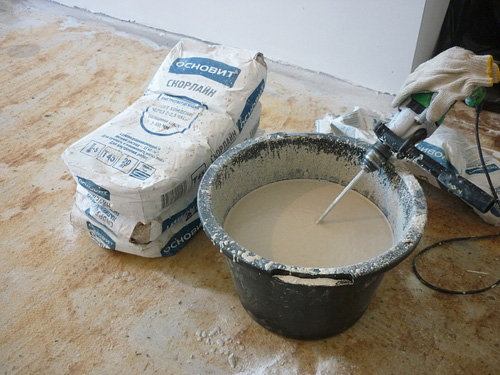
Advantages of self -leveling mixtures: what to look for?
- Environmental safety of material due to the lack of components with a negative environmental reputation in its composition. If we talk about the composition of bulk floors, then most often it includes Portland cement, quartz sand, pigments and polymer additives, as well as surface-active substances;
- The lack of difficulties in the process of preparing and using the mixture, since most of them are sold in dry form. Before direct use, the dry mixture is mixed with the required amount of water, which significantly simplifies the process of preparing it;
- Self -leveling mixtures are characterized by the minimum period of hardening, which is another significant advantage. To verify this and get acquainted with the deadlines for the self -leveling composition, read the accompanying instruction to the material;
- The minimum thickness of the applied layer, which is especially true for those who cannot boast of an apartment with high ceilings. The importance of this advantage is due to the fact that the correct design plays an important role in an integral perception of the interior of the room;
- A wide range of self -leveling mixtures for the floor presented in the construction market significantly expands the capabilities of the masters who made the choice in favor of these materials. At the same time, home craftsmen can choose both among products of both domestic and foreign manufacturers;
- As a result of the installation of the screed of the floor by a self -leveling mixture, the laying of which is carried out in a liquid form, which contributes to the fact that it spreads over the entire surface of the floor and qualitatively fills all changes and irregularities, a perfectly even surface of the floor is formed, suitable for the subsequent installation of the finish coating;
- Fire resistance is an important advantage of self -combating mixtures, thanks to which they are absolutely non -combustible;
- The insignificant weight of the self -leveling mixture layer contributes to the fact that additional loads are practically not posed on the supporting structures;
- The need for minimal preparatory work. In the process of aligning the floor by a self -leveling mixture, neither reinforcement nor set up additional beacons is required;
Disadvantages of the floor from a self -leveling mixture:
- The insufficient strength of the floor, which is determined by the thickness of the layer of screed not exceeding 5-20 mm. It is due to this that the manufacturer cannot guarantee high strength characteristics of the floor, the installation of which was carried out using a self -leveling mixture;
- Low heat and sound insulation characteristics, since the floor from a self-leveling mixture is not able to ensure the safety of heat and protection against noise pollution;
Self -leveling mixture for the floor: material consumption
In the process of installing the floor screed using a self -leveling mixture, it is necessary to correctly calculate dry material. On average, in order to fill 1 sq. Paul meters will require at least 2 kg of self -leveling mixture. In this regard, in order to correctly calculate the required amount of the mixture, the floor area must be multiplied by two. The floor screed, the installation of which is carried out using a self -leveling mixture, ideally should not exceed 10 mm. To make the calculation more accurate, experts recommend that the information on the material offered by its manufacturer. This information can always be found on the packaging of the composition. If we study the consumption of mixtures of the most famous manufacturers, then we can conclude that this indicator varies from 1 to 2 kg per 1 sq. A meter of flooring, while the thickness of the screed does not exceed 10 mm.
Pouring the floor with a self -leveling mixture: step -by -step instructions
Preparatory work before pouring floor
- This stage, like everyone else, is mandatory, since before starting to fill the floor by a self -leveling mixture, it is necessary to make sure that the strength of the subject and the absence of strong irregularities on the processed surface. In this regard, experts do not recommend using self -leveling mixtures to level wooden floors. As for gross irregularities, their leveling must be carried out using a half -dry screed for the floor.
- Before starting work, make sure that the existing floor screed is reliable. This is necessary so that in case of non -compliance with the floor filling technology, which contributes to the low adhesive characteristics of the upper layer of screed with the base. In this case, it is easily ripped off and needs to be removed;
- If there are visible surface defects, remove the existing screed and inspect the base for the presence of pollution. In case of detection of rust stains, treat the surface with copper sulfate. Pollution of various nature must be removed using cleaning agents or soapy solution, and eliminate areas and fungus using antiseptic drugs.
- Using the construction level, determine the height changes and, taking into account their size, select the most suitable mixture;
- To increase the adhesive characteristics of the surface, process the smooth base with abrasive materials;
- If you find cracks in the screed, they must be broken and cleaned of dust, and then fill out with the appropriate finishing composition;
- To reduce the absorption characteristics of concrete and increase the adhesive characteristics of the surface, process the base of a waterproof primer.
- To enhance the insufficiently strong reasons before the direct pouring of a self -leveling mixture, experts recommend using fiberglass, which is pointily fixed to the floor.
Recommendations of specialists who must be observed in the process of preparatory work:
- These work must be done at a temperature that enters the range from +15 to +30 degrees, and relative humidity of no more than 50-65 %;
- To make sure of the strength of the base, use special devices, such as Kashkarova's hammer, Ri-ri and other materials;
- In order to carefully observe the technology of pouring the floor with a self -leveling mixture, it is necessary to protect the mixture from premature moisture loss, and it is also forbidden to accelerate its drying time, for example, by including the floor heating system.
Filling the mixture The fundamental stage of work
- After completing the preparatory phase, you can start the main stage of work pouring the mixture. Before this, it must be diluted in a clean container using the required amount of water and mixed thoroughly using a punch equipped with a mixer nozzle;
- Application of the solution can be carried out in two ways: manually using a spatula or machine. It is important to observe the necessary speed of work, since the mixture is characterized by a sufficiently high drying rate, not exceeding 15-60 minutes.
Important! If you are an inexperienced master, experts recommend performing this stage of work together, while one person will knead the solution in small portions, and apply the second to the floor surface. In this case, the breaks between its application should not exceed 15 minutes.
- The solution ready for use must be poured out of the container and evenly distribute it with a spatula over the entire surface of the floor. At the same time, the flooring in small rooms can be carried out in one appointment.
Important! In order to fill the floor with a self -leveling mixture in large rooms, they must be divided into several small areas using temporary limiters, such as boards or a metal profile. Pouring these sites is carried out through one, and after their drying, the limiters remove and fill the remains.
- To carry out uniform application of the solution after filling it and its primary leveling, use the rushing roller. It is especially important to roll the junctions with neighboring layers with a roller.
Important! To freely move along the wet layer of screed, experts recommend purchasing sandals equipped with spikes.
- To carry out machine filling, special mixing and smitting devices are used, which helps to accelerate technical work. To monitor the amount of the applied solution, use the method for determining the diameter of the spreading spot, which is compared with the parameters proposed by the manufacturer.
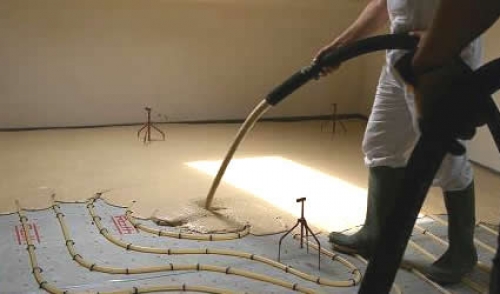
In more detail, the process of filling the floor with a self -leveling mixture can be found by watching the video presented in the article.
Fill the floor with a self -leveling mixture of a video

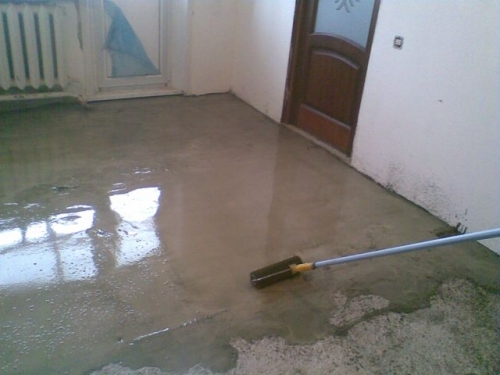
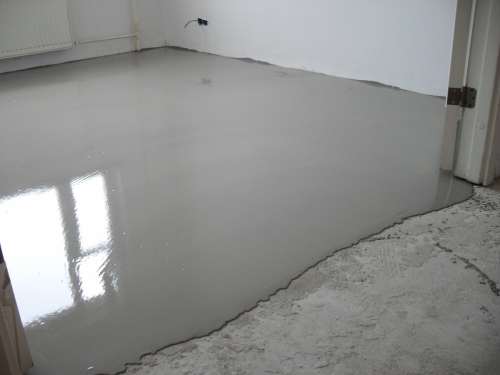
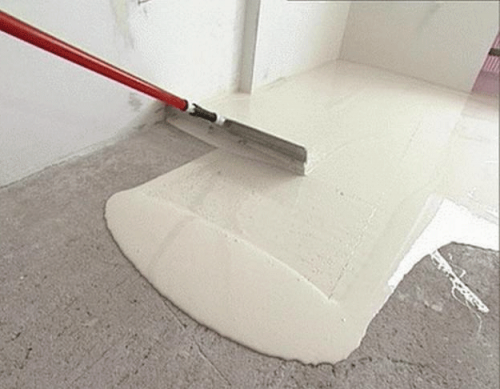
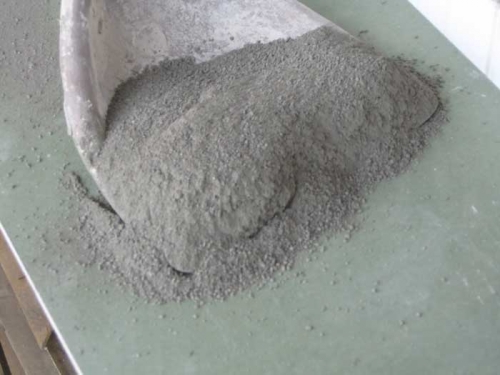
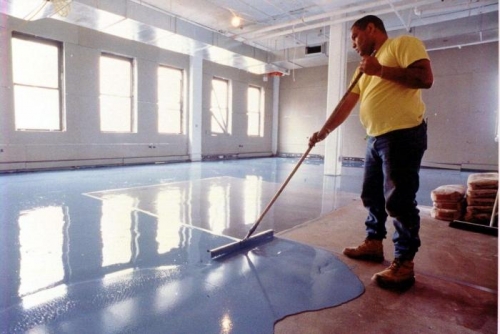
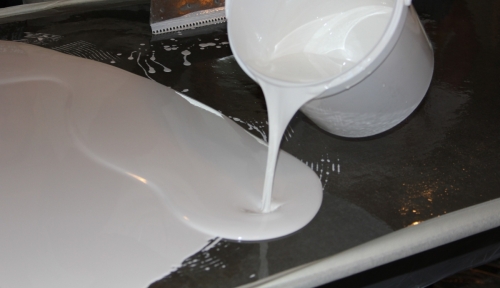
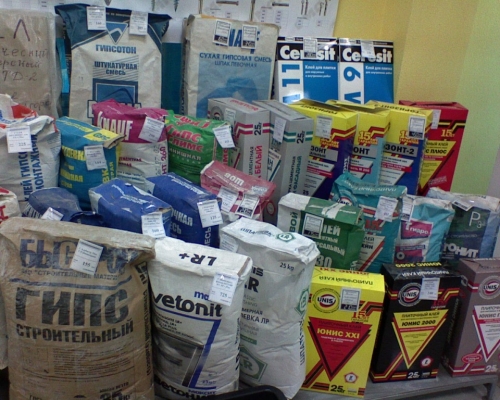
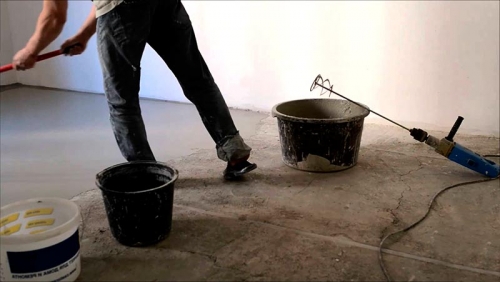
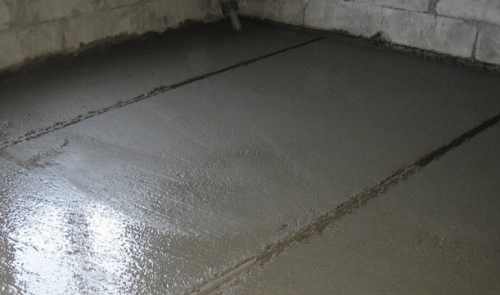
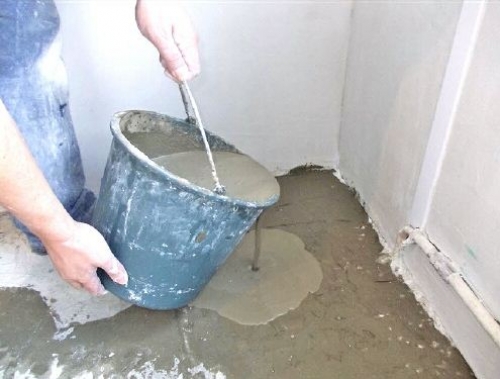
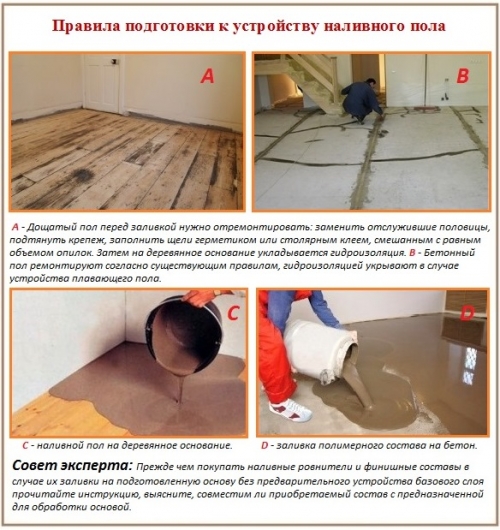
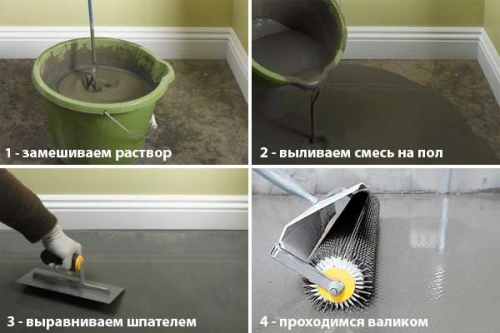

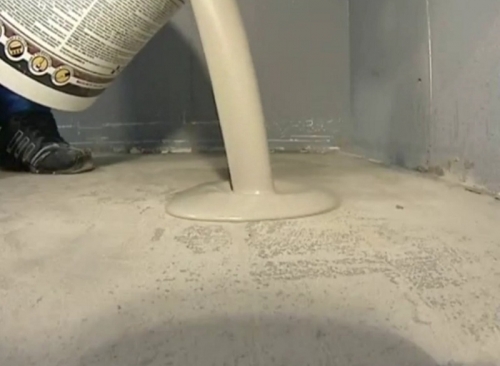
Gypsum -based mixtures
"Gypsum -based mixtures are in a lower price category ..." and "... ... an undeniable advantage of a gypsum mixture is a quick drying time ...... as for the disadvantages - the main one is a high price." What is it like?
some kind of mutota, everything
some kind of mutota, everything is mixed up